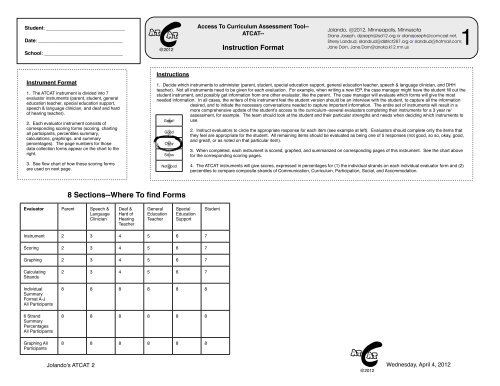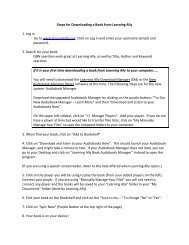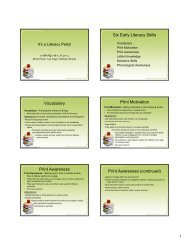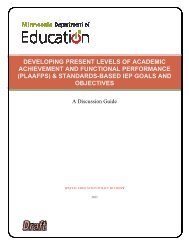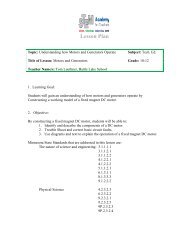ATCAT Instrument 2012 1
ATCAT Instrument 2012 1
ATCAT Instrument 2012 1
Create successful ePaper yourself
Turn your PDF publications into a flip-book with our unique Google optimized e-Paper software.
Student: ____________________________<br />
Date: ______________________________<br />
School: ____________________________<br />
<strong>ATCAT</strong><br />
@<strong>2012</strong><br />
Access To Curriculum Assessment Tool--<br />
<strong>ATCAT</strong>--<br />
Instruction Format<br />
Jolando, @<strong>2012</strong>, Minneapolis, Minnesota<br />
1<br />
Diane Joseph, djoseph@isd12.org or dianejoseph@comcast.net,<br />
Sherry Landrud, sllandrud@district287.org or slandrud@hotmail.com;<br />
Jane Dorn, Jane.Dorn@anoka.k12.mn.us<br />
<strong>Instrument</strong> Format<br />
1. The <strong>ATCAT</strong> instrument is divided into 7<br />
evaluator instruments (parent, student, general<br />
education teacher, special education support,<br />
speech & language clinician, and deaf and hard<br />
of hearing teacher).<br />
2. Each evaluator instrument consists of<br />
corresponding scoring forms (scoring, charting<br />
all participants, percentiles summary,<br />
calculations, graphings, and summary<br />
percentages). The page numbers for those<br />
data collection forms appear on the chart to the<br />
right.<br />
3. See flow chart of how those scoring forms<br />
are used on next page.<br />
Instructions<br />
1. Decide which instruments to administer (parent, student, special education support, general education teacher, speech & language clinician, and DHH<br />
teacher). Not all instruments need to be given for each evaluation. For example, when writing a new IEP, the case manager might have the student fill out the<br />
student instrument, and possibly get information from one other evaluator, like the parent. The case manager will evaluate which forms will give the most<br />
needed information. In all cases, the writers of this instrument feel the student version should be an interview with the student, to capture all the information<br />
desired, and to initiate the necessary conversations needed to capture important information. The entire set of instruments will result in a<br />
more comprehensive update of the student’s access to the curriculum--several evaluators completing their instruments for a 3 year re/<br />
assessment, for example. The team should look at the student and their particular strengths and needs when deciding which instruments to<br />
Great! use.<br />
4<br />
3<br />
Good<br />
2<br />
Okay<br />
1<br />
So so<br />
0<br />
Not good<br />
2. Instruct evaluators to circle the appropriate response for each item (see example at left). Evaluators should complete only the items that<br />
they feel are appropriate for the student. All remaining items should be evaluated as being one of 5 responses (not good, so so, okay, good,<br />
and great!, or as noted on that particular item).<br />
3. When completed, each instrument is scored, graphed, and summarized on corresponding pages of this instrument. See the chart above<br />
for the corresponding scoring pages.<br />
4. The <strong>ATCAT</strong> instruments will give scores, expressed in percentages for (1) the individual strands on each individual evaluator form and (2)<br />
percentiles to compare composite strands of Communication, Curriculum, Participation, Social, and Accommodation.<br />
8 Sections--Where To find Forms<br />
Evaluator Parent Speech &<br />
Language<br />
Clinician<br />
Deaf &<br />
Hard of<br />
Hearing<br />
Teacher<br />
General<br />
Education<br />
Teacher<br />
Special<br />
Education<br />
Support<br />
Student<br />
<strong>Instrument</strong> 2 3 4 5 6 7<br />
Scoring 2 3 4 5 6 7<br />
Graphing 2 3 4 5 6 7<br />
Calculating<br />
Strands<br />
Individual<br />
Summary<br />
Format A-J<br />
All Participants<br />
6 Strand<br />
Summary<br />
Percentages<br />
All Participants<br />
Graphing All<br />
Participants<br />
2 3 4 5 6 7<br />
8 8 8 8 8 8<br />
8 8 8 8 8 8<br />
8 8 8 8 8 8<br />
Jolando’s <strong>ATCAT</strong> 2<br />
<strong>ATCAT</strong><br />
@<strong>2012</strong><br />
Wednesday, April 4, <strong>2012</strong>


